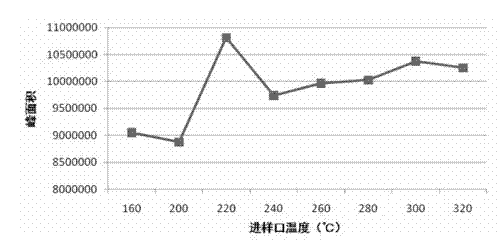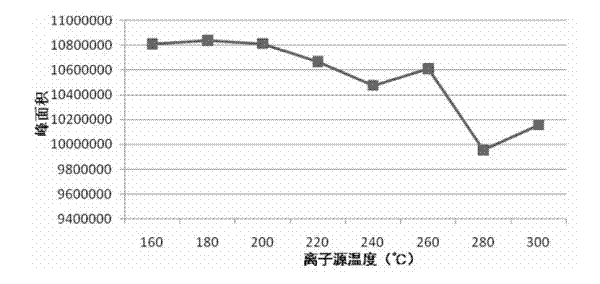Detection method for special fire retardant content in textile
A detection method and flame retardant technology, which are applied in the detection field of flame retardants
- Summary
- Abstract
- Description
- Claims
- Application Information
AI Technical Summary
Problems solved by technology
Method used
Image
Examples
Embodiment 1
[0059] Example 1. Optimization and selection of parameters when gas chromatography-mass spectrometer measures
[0060] In order to obtain suitable gas chromatography-mass spectrometry parameters, screen and optimize instrument parameters:
[0061] Instruments used: GC-MS 2010plus gas chromatography-mass spectrometry (SHIMAZU, Japan), equipped with AOC20i+s autosampler, Rxi-5MS quartz capillary column, 30 m × 0.25 mm (i.d.) × 0.25 mm, or equivalent;
[0062] (1) Optimization of the inlet temperature
[0063] Select different inlet temperatures, and observe the change of the chromatographic peak area of each target compound (see figure 1 ), the results showed that for TEPA, as the inlet temperature increased, the chromatographic peak area of the TEPA target compound reached the highest point at 220 °C, and then the peak area decreased slightly and tended to be flat. Therefore, the inlet temperature selected in the present invention is 220°C.
[0064] (2) Optimizat...
Embodiment 2
[0077] Example 2: The detection method of tri-[aziridine]-phosphine oxide content in textiles comprises the following steps:
[0078] (1) Sample preparation
[0079] Take 5.0 ~ 10.0 g of cotton fabric sample, cut it to less than 0.5 cm × 0.5 cm, and mix well;
[0080] (2) Sample extraction
[0081] Weigh 1.00 g of the above-mentioned cotton fabric sample and place it in a 5 mL extraction tank, extract it with a fast solvent extraction apparatus, the extraction agent is a mixture of n-hexane and acetone, the volume ratio of the two is 7:3, and the extraction temperature is 60 °C , the pressure was 10.34 MPa, static extraction was performed for 5 min, and each sample was extracted 3 times cyclically. After each extraction, it was washed with 60% of the extraction solvent of the extraction cell volume, and finally purged with nitrogen, and the extraction solution was collected in a 60 mL belt. Transfer the collected extraction solution to a 125 mL chicken heart bottle in a co...
Embodiment 3
[0111] Example 3: Establishment of linear relationship in the detection of tris-[aziridine]-phosphine oxide content in textiles:
[0112] Using the method in Example 2, use the TEPA standard solution diluted with blank matrix solution for GC-MS analysis, the prepared concentrations are: 1 mg / L, 4 mg / L, 10 mg / L, 20 mg / L, 30 mg / L, the determination results were analyzed by the workstation software, the determination linear range was 1-100 mg / L, and the detection limit LOD was 1 mg / L. Take cotton fabric as an example, get the standard curve spectrogram see Figure 7 , the abscissa in the figure indicates concentration (mg / L), and the ordinate indicates (peak area). For actual samples, the lower limit of determination LOQ is less than 4 mg / L. Under the experimental conditions determined by this method, the linear equations and correlation coefficients of other matrices are shown in Table 4 (where Y is the peak area; X is the concentration of TEPA, mg / L). The results showed th...
PUM
| Property | Measurement | Unit |
|---|---|---|
| ionization potential | aaaaa | aaaaa |
Abstract
Description
Claims
Application Information
 Login to View More
Login to View More - Generate Ideas
- Intellectual Property
- Life Sciences
- Materials
- Tech Scout
- Unparalleled Data Quality
- Higher Quality Content
- 60% Fewer Hallucinations
Browse by: Latest US Patents, China's latest patents, Technical Efficacy Thesaurus, Application Domain, Technology Topic, Popular Technical Reports.
© 2025 PatSnap. All rights reserved.Legal|Privacy policy|Modern Slavery Act Transparency Statement|Sitemap|About US| Contact US: help@patsnap.com



